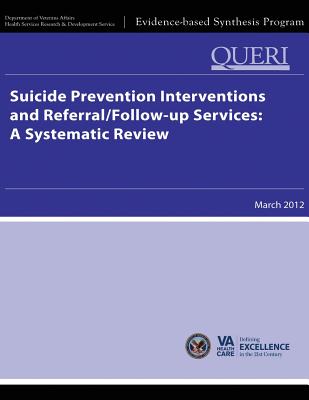Suicide is the tenth leading cause of death in the United States (U.S.), with nearly 100 suicides occurring each day and over 36,000 dying by suicide each year. Among Veterans and current military, suicide is a national public health concern. Recent estimates suggest current or former military represent 20 percent of all known suicides in the U.S. and the rate of suicides among Veterans utilizing Veterans Health Administration (VHA) services is estimated to be higher than the general population. The enormity of the problem has led to several major public health initiatives and a growth in research funding for suicide prevention. Despite recent suicide prevention efforts, the suicide rate in the U.S. has changed relatively little over the past 100 years. The body of research on suicide prevention approaches has been reviewed previously by Gaynes and colleagues, and Mann and colleagues, and recent, similar work exists in the form of draft self-harm guidelines from the National Institute for Health and Clinical Excellence (NICE) in 2011. As requested by the Veterans Affairs (VA)/Department of Defense (DoD) Evidence Based Practice Working Group (EBPWG) on suicide prevention, we examined recent research on suicidal self-directed violence as defined by Crosby et al. 2011. We update the work of Gaynes et al. and Mann et al. by systematically reviewing relevant literature that was not included in either report, and was published in 2005 through November 18, 2011. Though the focus of the report is on suicide prevention, we include as outcomes any type of suicidal self-directed violence, defined as "Behavior that is self-directed and deliberately results in injury or the potential for injury to oneself. There is evidence, whether implicit or explicit, of suicidal intent." The key questions were: Key Question #1. What is the effectiveness of specific interventions for reducing rates of suicidal self-directed violence in military and/or Veteran populations? Key Question #2. What lessons can be learned from suicidal self-directed violence prevention intervention research conducted outside of Veteran or military settings that can be applied to Veteran and/or military populations? Key Question #3. What is the effectiveness of referral and follow-up services (e.g., strategies designed to provide referrals, improve referral follow-through and attendance, etc.) for reducing rates of suicidal self-directed violence in military and/or Veteran populations? Key Question #4. What lessons can be learned from research on suicidal self-directed violence referral and follow-up services conducted outside of Veteran or military settings that can be applied to Veteran and/or military populations?
| FindBook |
有 1 項符合
Suicide Prevention Interventions and Referral/Follow-up Services: A Systematic Review的圖書 |
 |
Suicide Prevention Interventions and Referral/Follow-up Services: A Systematic Review 作者:U. S. Department of Veterans Affairs(COR)/Health Services Research & Development Service 出版社:Createspace Independent Publishing Platform 出版日期:2013-05-23 語言:英文 規格:平裝 / 168頁 / 27.9 x 21.6 x 1 cm / 普通級 |
| 圖書館借閱 |
| 國家圖書館 | 全國圖書書目資訊網 | 國立公共資訊圖書館 | 電子書服務平台 | MetaCat 跨館整合查詢 |
| 臺北市立圖書館 | 新北市立圖書館 | 基隆市公共圖書館 | 桃園市立圖書館 | 新竹縣公共圖書館 |
| 苗栗縣立圖書館 | 臺中市立圖書館 | 彰化縣公共圖書館 | 南投縣文化局 | 雲林縣公共圖書館 |
| 嘉義縣圖書館 | 臺南市立圖書館 | 高雄市立圖書館 | 屏東縣公共圖書館 | 宜蘭縣公共圖書館 |
| 花蓮縣文化局 | 臺東縣文化處 |
|
|
圖書介紹 - 資料來源:博客來 評分:
圖書名稱:Suicide Prevention Interventions and Referral/Follow-up Services: A Systematic Review
|










